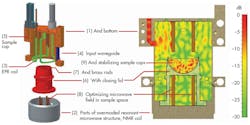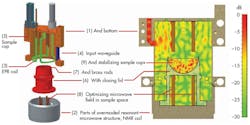EM Simulation Software Optimizes Large Microwave Cavities
This file type includes high resolution graphics and schematics when applicable.
Industrial heating often requires heating objects with complex thermal profiles and long run times. To reduce energy and optimize the heating of certain materials, microwave cavity heating devices often save energy while enhancing performance. Microwave heating is used to dry fabrics, wood, and fiberglass. Additionally, it can be used to eradicate pests in food crops, pasteurize pasta, cure synthetic/composite materials, and post-cure optoelectronic adhesives. To effectively heat these materials on an industrial basis, large microwave cavities with complex modes must be simulated. CST AG gives insight into modeling such cavities in a whitepaper titled, “Modeling Of Large Microwave Cavities For Industrial And Scientific Applications.”
The design of a large microwave cavity heater involves the following challenges: controlling the power distribution within the volume; controlling well-defined E-field/B-field distributions; and optimizing the amount of microwave energy delivered to the goods being processed. As the cavity size is often electrically large, simulating tens to thousands of cubic wavelengths can be computationally intensive. Inclusion of the microwave source also can be critical for effectively profiling the cavity. In fact, it may require special software integration. An additional challenge could be modeling moving microwave sources, such as rotating field stirrers.
To tackle these issues, a software suite is needed that can efficiently model both the time and frequency domains with high levels of accuracy. Having the ability to perform a frequency-domain simulation enables an accurate, resonant description to be achieved in a reasonable amount of simulation time. For larger cavities, having a simulation solver with quality sub-gridding techniques can typically reduce the computational demand while maintaining critical simulations in areas that require high detail.
As an example, a multi-sample dissolution-dynamic-nuclear-polarization (DNP) system operating at 94 GHz with cryogenic cooling is simulated. The DNP is used to polarize particles within water. As a result, patients will provide stronger imaging signals during a magnetic-resonance-imaging (MRI) scan because of the liquid in their bodies.
The 218-cubic-wavelength volume is effectively simulated. The design renders 10- to 20-mW power requirements for maximum DNP enhancement. The power requirement gained from simulating reduces the thermal stress in the sample. In doing so, it induces higher polarization levels compared to other designs.
CST, Bad Nauheimer Str. 19, Darmstadt, Germany 64289, +49 615-173-030
This file type includes high resolution graphics and schematics when applicable.
About the Author
Jean-Jacques DeLisle
Jean-Jacques graduated from the Rochester Institute of Technology, where he completed his Master of Science in Electrical Engineering. In his studies, Jean-Jacques focused on Control Systems Design, Mixed-Signal IC Design, and RF Design. His research focus was in smart-sensor platform design for RF connector applications for the telecommunications industry. During his research, Jean-Jacques developed a passion for the field of RF/microwaves and expanded his knowledge by doing R&D for the telecommunications industry.


